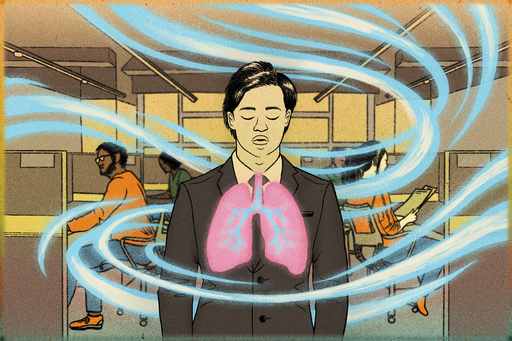
In New York, Myosin Marketing has adopted an unusual ritual that marks the beginning of every staff meeting during Zoom calls. CEO Sean Clayton initiates a deep-breathing exercise, aiming to create a supportive atmosphere for his team, most of whom work remotely. According to Clayton, this practice not only helps in calming nerves but also prepares employees to engage in creative discussions without fear of judgment.
Initially, some team members were hesitant and even found the exercise strange, leaving their cameras off and feeling awkward. However, after experiencing the benefits over time, the perspective shifted as employees began to appreciate the practice, expressing sentiments like “this feels good.” Research indicates that deep-breathing exercises can significantly alleviate workplace stress, something essential in today’s fast-paced environment.
Many employees may not realize that their breathing tends to become shallow during work, especially for those sitting at desks or engaging in physically demanding jobs. Chronic stress is known to lead to serious health issues, likened in risk levels to that of secondhand smoke, according to health experts. Deep-breathing techniques have been linked to lower blood pressure and diminished anxiety, presenting an accessible and effective coping mechanism.
Experts point out that deep breathing is a readily available method that requires little time—just a minute or two can suffice to refocus and reduce stress. Lisa Marie Deleveaux, a marketing professional, finds that setting aside early mornings for breathing exercises helps her regain clarity and composure. She practices various techniques, including alternate nostril breathing, which involves rhythmic inhaling and exhaling that can quiet the mind.
Cardiologist Glenn Levine supports the notion that dedicating one to five minutes to breathing can help people clear their thoughts and regain focus, much like rebooting a computer overloaded with tasks. Levine emphasizes that deep-breathing exercises can be performed even at desks, allowing a break from screens.
On the other hand, Lindsay Carlisle initiates breathwork with her daughter during their commute, focusing on mindful breathing patterns that promote relaxation. This practice has helped her manage anxiety, enabling her to maintain calmness before significant work tasks.
Suze Yalof Schwartz, who transitioned from a high-pressure fashion career to founding Unplug Meditation, emphasizes the importance of breath control in signaling our brains to remain calm amid chaos. She trains various professionals to utilize breathing techniques, like the box breathing method—an exercise involving structured breath patterns designed to enhance focus and reduce anxiety before challenging work conversations.
Notably, corporations like Coca-Cola and Netflix have engaged Schwartz’s meditation company to instruct employees on these beneficial techniques. Incorporating breathing exercises into daily routines can be challenging for many, particularly in customer-facing roles. Schwartz encourages workers to utilize moments in their day, like ringing up customers, to practice mindful breathing.
To further encourage consistency, employees can set reminders or display motivational notes at their workspaces. Carlisle finds that small reminders help keep her accountable to her breathing practice, reinforcing her ability to counteract persistent anxiety with this simple yet effective tool.
As workplaces continue to evolve, integrating such wellness strategies may be essential for maintaining mental health and productivity.
